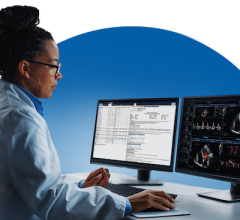
December 12, 2018 — Sigmascreening recently announced that more than 100,000 women have had mammography exams with the Sensitive Sigma Paddle to ensure optimum mammographic compressions. Sigmascreening showcased the technology at the 104th Radiological Society of North America (RSNA) annual meeting, Nov. 25-30 in Chicago.
The Sensitive Sigma Paddle was highlighted in a study presented at RSNA that demonstrated the impact of a real-time pressure indicator during mammographic exam acquisition. The study, “Mammographic Compression Variability Increased after Removing Real-Time Pressure Indicator,” was presented by Monique van Lier, clinical application scientist from the Netherlands, during the Physics Breast X-Ray Imaging Session.
The Sensitive Sigma Paddle attempts to standardize the compression procedure by introducing pressure-based compression using a paddle equipped with a real-time pressure indicator. In the study, researchers evaluated the impact on compression practice when replacing the pressure-based paddle with a conventional paddle without pressure indication in a group experienced technologists.
Results showed that after removal of the pressure indicator, the average compression pressure and variance significantly increased, leading to more unfavorable over- and under-compression. The proportion of compressions in the pressure range 5-15 kPa decreased from 87.4 percent to 77.9 percent. The proportion of high pressures (>15kPa) nearly doubled (11 percent to 18.8 percent) and low pressures (<5kPa) more than doubled (1.6 percent to 3.3 percent). The results suggest that when removing the pressure indicator, compression variability increased rapidly, indicating that an indicator is needed to maintain compression reproducibility.
To get the best image quality during a mammogram with the least amount of radiation, the breast needs to be flattened or compressed with a reasonable and repeatable amount of pressure. However, lack of standardization can lead to variability in compression. Under-compression can lead to blurred breast images, more retakes and a higher average glandular dose (AGD), while over-compression causes discomfort and unnecessary pain for the patient
Based on breast-size and tissue-stiffness, the Sensitive Sigma Paddle calculates the pressure to achieve an optimal compression range and allows for a highly reproducible procedure. A real-time pressure indicator provides women more control over the compression of their breasts and enhances interaction between the technologist and the patient about the progress of the compression procedure. This makes communication easier because of the fact that the patient is more involved, making the examination less stressful, with overall better image quality, lower radiation dose and a faster workflow.
For more information: www.sigmascreening.com


 December 10, 2025
December 10, 2025 









